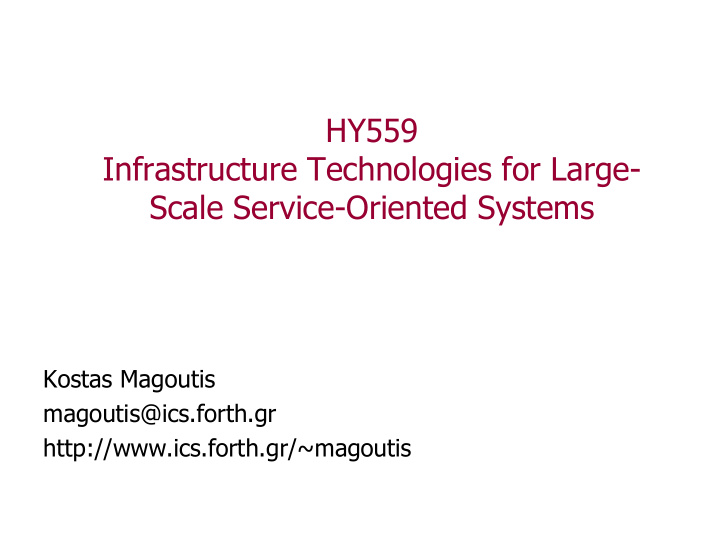



HY559 Infrastructure Technologies for Large- Scale Service-Oriented Systems Kostas Magoutis magoutis@ics.forth.gr http://www.ics.forth.gr/~magoutis
Cloud Computing • Applications delivered as a service over the Internet – Long referred to as “Software as a Service” • Hardware and systems-software in the datacenters that provide above services – The “Cloud” • There are different flavors of Cloud Computing – Available in a “pay as you go” manner to general public • Service being sold is Utility Computing – Internal data centers of businesses or other organizations • Private Clouds (as opposed to Public Clouds defined above) HY-559 Spring 2013
Users and providers of Cloud Computing HY-559 Spring 2013
New aspects of Cloud Computing • Illusion of infinite computing resources available on demand – No need to plan far ahead for provisioning • Elimination of upfront commitment by Cloud users – Possible to start small and grow resources as needed • Ability to pay for use of computing resources on short-term basis, as needed, release them as needed – Reward conservation HY-559 Spring 2013
When is Cloud Computing a viable business • Construction and operation of extremely large-scale, commodity-computer datacenters at low-cost locations uncovers large economies of scale – Factors of 5-7 decrease in cost of electricity, network bandwidth, operations, software, hardware HY-559 Spring 2013
When is Cloud Computing a viable business • Statistical multiplexing increases utilization compared to private Cloud – Possible to offer service at low cost, make good profit • Leverage existing investment – Example: Amazon • Defend a franchise – Example: Microsoft applications HY-559 Spring 2013
When is Cloud Computing a viable business • Leverage customer relationships – Example: IBM Global Services • Become a platform – Example: Facebook HY-559 Spring 2013
Cloud client benefits • Transfers risk of misestimating load to Cloud provider – Peak vs. average expected load HY-559 Spring 2013
Cloud client benefits • No penalty from unexpectedly scaling down • Track variable rates of hardware cost reduction • Avoid practical limits on utilization of purchased equipment, operational costs HY-559 Spring 2013
Key technologies (1) • Highly-scalable software systems – Initially built to support internal needs (Google, Amazon) • Statistical multiplexing by virtualizing resources – Computation, storage, communication • Ubiquitous remote access over Web services APIs – SOAP, REST HY-559 Spring 2013
Key technologies (2) • Fine-grain monitoring and charging for resource use – Must be built ground-up • Multi-tenancy for fine-grain co-location of clients • Service-level agreements (SLAs) HY-559 Spring 2013
What are the different offerings? Distinguished based on level of abstraction and level of resource management: • Amazon EC2 – Low level, physical hardware view (VMs) • Microsoft Azure – .NET libraries, Common Language runtime • Google AppEngine – Traditional Web application style HY-559 Spring 2013
Top obstacles to cloud computing 1. Availability of service 2. Data lock-in 3. Data confidentiality 4. Data transfer bottlenecks 5. Performance unpredictability 6. Scalable storage 7. Bugs in large-scale distributed systems 8. Scaling quickly 9. Reputation fate sharing 10.Software licensing HY-559 Spring 2013
Recommend
More recommend